Dell Ultrasharp 2408WFP Review
A couple of months back I started a quest to upgrade my aging 19" LCD. First, I bought a Samsung SyncMaster 2232GW which I'd seen a friend of mine use. This turned out to be a disappointment - I didn't care much for the glossy finish or the shiny black case, but the real deal breaker was the colour banding and, to a lesser degree, RTC artefacts. After reading lots about the different LCD panel types, I decided that I had to get a display that isn't based on TN technology. The Dell Ultrasharp 2408WFP is one of three monitors based on the same Samsung S-PVA panel (the other two being the Samsung 245T and the aging HP LP2465). Short of high-end LaCie and NEC monitors, these three together with the Apple Cinema Displays are the only high-quality enthusiast-level LCDs available in South Africa at present. The Apple Cinema Displays don't play very nicely with PCs (they don't have a built-in scaler so text mode in particular does not work) so I went ahead and ordered the Dell based on my very good experience with the Ultrasharp 1707FPs I use at work.
For the advanced PC or Mac user who values wide viewing angles and colour accuracy, this is an excellent LCD. Dell recommends this monitor for "accurate color representation" in the "home and office", and describes it as offering a "satisfying viewing experience when engaging in digital content creation, gaming and HD entertainment". Depending on where you're coming from, this could be the best monitor you've ever seen or just not good enough to make the grade. Read on for my experience with it. Ergonomics and connectivity are certainly top notch. One possible issue is the extended colour gamut - colour managed apps will display colour accurately, but some apps will have ridiculous neon colours as a result. Lightroom, Photoshop CS3, the Vista desktop (Explorer, photo viewer etc.), and Mozilla Firefox (once configured) all work correctly.
I ordered my monitor on September 4, 2008 and received the original revision, despite a firmware update being released all the way back in June already! I wouldn't ordinarily mind but the original firmware only allows the user to adjust sharpness in increments of 25. The default value of 50 is too high, causing colour halos around text. Dropping it to 25 results in a picture that is way too soft. This also tends to emphasize grain in photos and jagged lines in vector graphics. The new revision firmware should sort this out but don't assume that you'll get it - you might need to send it back to Dell for an update.
What is a more serious issue for graphics/photography users is the so-called "contrast shift" or "gamma shift" that is inherent to PVA matrices. This means that the halftones will shift in brightness when viewed off-centre. This is a major problem as you only need to move your head a few centimeters to notice it. With a panel of this size, simply moving an image from one side of the screen to the other will result in a visible change as you drag the window across. This is the reason we don't buy cheap TN panels in the first place! Except, TN panels change contrast when you move your head up and down. PVA panels change (and quite significantly) when you move left to right. This is arguably even worse, as monitors are wider than they are tall, and typically you'll stay at a constant height when sat in front of a computer.
My last problem with this monitor is hard to describe - some users report is as "DLP-like colour rainbows". I can notice it easily if there is some white text on a black background (e.g. a command shell), or a low-key black and white image on the screen, and move my eyes from one side of the screen to the other. As your eyes move across the screen, the B&W image will temporarily appear to have vivid red/green/blue colour stripes across it. This effect happens to me often enough (without specifically looking for it) to be annoying.
Now onto the positives, of which there are many. The stand is excellent - moves smoothly, yet manages to be well damped. It has a small footprint yet is very stable, and rotates nicely along the vertical axis. The portrait orientation pivot feature might come handy to some. The monitor looks like a serious piece of kit and feels very well put together. On the back, there are all the inputs one could wish for - including the new DisplayPort connector. I think it's particularly well suited for general multimedia and productivity tasks. Watching video on it is fantastic thanks to bright colours and wide viewing angles. Gaming is another strong point - I tried Crysis (using PC over DVI, scaled from 1600x1000) and Call of Duty 4 (Xbox 360 over VGA connection, scaled from 1280x800), both were stunning although I still prefer my couch + plasma TV when it comes to recreation ![]()
My monitor is going back to Dell as a result of the above mentioned issues. I still believe it is a very solid choice but not the right one for me. However besides the inherent S-PVA problem of contrast shift, the remaining issues are inexcusable at this price level from a major manufacturer like Dell. Especially when a fix for at least one of them has been available for some months now. Service from Dell SA was outstanding though so I'll be more than happy to deal with them again. In the mean time, I'll be waiting for the new HP LP2475w to launch in SA. This monitor uses the latest generation H-IPS panel from LG and so has the potential to be even better than the Apple Cinema HD Display 23" and as good as the Apple iMac 24" (but without the glossy finish).
Other reviews from around the 'net: TFT Central, TrustedReviews.
Wacom Intuos 3 Tablet on Vista Problem (with Solution)
Wacom makes the best graphics tablets there are, no question about it. Recently however I started experiencing a weird issue where the tablet work work just fine in Adobe Lightroom or Photoshop, but not outside of these programs. After trying several different driver revisions it was clear that the problem was somehow related to Windows itself and not with the tabler or drivers - switching the pen from "pen mode" to "mouse mode" would actually make it work everywhere. However this has the downside of changing the tabled pointing mode from absolute coordinates to relative - so it works more like a touchpad than a tablet; this is undesirable as it completely mostly defeats the point of having a tablet whose surface is mapped directly to the screen.
The winning answer came courtesy of Mr Benedikt Schmitt of Wacom Europe, who offered the following solution: from the Windows Device Manager, disable the "Wacom Virtual Hid Driver" device. (Go to Control Panel > System and Maintenance > Device Manager, find the driver, right-click it and choose "Disable".) One reboot later (welcome to Windows-land, circa 2008?), everything works as desired. Pressure and tilt sensitivity inside Photoshop still work, and the pen functions just fine in the rest of the Windows desktop. The absolute mapping makes it an absolute pleasure to point quickly and precisely. It makes my laser mouse feel rather clumsy navigating a large 24" screen!
I Have a Space Camera!
The Pentax K10D travels to space! (And back in one piece, presumably ![]() ) [Via]
) [Via]
Lightroom as a DAM Tool and Metadata Stats
Everyone loves stats! I built a giant Lightroom catalogue of all my photos since 2004 — about 20,500 odd. Much to my surprise, it worked superbly well. This is one area in which Lightroom 2 is a vast improvement over version 1 which started slowing down noticeably when my catalogs reached a size of about 10k photos (although I have also upgraded my machine since last I tried that). Having so many photos lets you get a birdseye view of your own shooting habits and equipment. So here is a summary from the metadata view:
Top cameras:
- Pentax K100D - 11,972
- Pentax K10D - 3,636
- Pentax *ist DL - 1,938
- Canon EOS 350D - 1,471
- Fuji FinePix 4700z - 560
- various other point-and-shoots, film scans, edits
Of those, I still have the K10D and the K100D. Although I've had the K10D for about the same time that I had the K100D before, I took all my photos in Namibia and Europe last year with the K100D hence the much higher picture count from with body.
Top Pentax lenses:
- Pentax DA 50-200mm F4-5.6 ED - 6,713
- Pentax DA 16-45mm F4 ED AL - 5,069
- Pentax FA 50mm F1.4 - 2,911
- Pentax DA 18-55mm - 2,204
- various K/M/A lenses - 628
- various others
The 16-45/4 is the lens most likely to be found on the front of my K10D these days but I've shot all the fashion weeks with the 50-200 for lack of a better lens and those generate tons of shots in a short space time. This accounts for the puny 50-200 having so many pics against it! Otherwise the 16-45 is my favourite lens - great optical quality, light, and almost-but-not-quite wide enough standard zoom (equivalent to 24-70mm in 35mm terms).
*DAM = Digital Asset Management, i.e. handling very large media libraries.
The Streets of Sandton
Pics from the Saturday photo walk around Sandton. The complete set is over at Flickr.
Worldwide Photo Walk
I saw this mentioned on Photoshop User TV, and - surprise, surprise - there was even a Johannesburg edition! Scott Kelby is promoting his new Lightroom 2 book as part of a Worldwide Photo Walk, I figure it should be good fun. Starts at 9:30, 23rd August in Sandton - register to reserve your spot.
Windows Vista Chronicles
I recently upgraded my desktop PC at home to Vista and the results were rather surprising. I found XP to be getting a bit old and dabbling in some hackintosh experiments only made its age more apparent. While Apple's OS is excellent, my old graphics card died and I could never get the replacement to play nicely with Leopard. There were several other small niggles (all due to the nature of the hack) with that installation but I liked OS X well enough to consider buying a Mac.
The trouble with the current Apple Mac line-up is that I wanted a desktop machine which only leaves the Mac Pro, and that's frankly way out of my reach. The iMac is nice but using laptop internals in an all-in-one design means it is a bit underpowered for what you pay, and totally lacking in the extensibility dept. For photography in particular the 24" model is a far better bet as it uses a fancy H-IPS LCD panel. These do not suffer from contrast and colour shifts related to viewing angle changes and are better than the common 6-bit TN panels. At that price I'd rather buy a separate LCD that I can connect to other things too, thank you very much. So while waiting for the mythical midrange Mac minitower, Vista SP1 got released and my curiosity got the better of me.
Naturally, there were a few issues along the way. One of the first was a documented problem - my screen saver was not kicking in, no matter what. Turns out that this is caused by none other than a piece of Microsoft hardware! Oh the irony. Certain types of Microsoft wireless keyboard/mouse USB receivers cause this and the solution is to install the "Microsoft - Other hardware - HID Non-User Input Data Filter" update from Windows Update. Bizarrely, this is an optional update so you have to explicitly get it.
Another issue is the well publicized problem with monitor calibration settings being lost after sleep, UAC prompts, or after starting full-screen games. It seems as though the video card Look-Up Tables (LUT) get reset on any of the above mentioned events. No real solution in sight - my workaround is to place a shortcut to the spyder2express start-up item on my Start Menu and run it manually if I notice that the calibration is lost. (If you're using a ColorVision spyder product, you will find an item called ColorVisionStartup under All Programs > Startup. Just drag it somewhere convenient or assign a keyboard shortcut via its properties panel. Other calibration solutions will probably have a similar loader program.) Windows really needs better support for this - Mac OS X does it brilliantly via System Preferences, no need for proprietary utilities to load the LUT.
I do pretty much all my digital photography in Pentax’s proprietary raw format called PEF. Although my primary camera is one of the few that support Adobe’s DNG file format, the PEF format as implemented in it offers lossless compression and thus better shooting capacity. I import my files with Adobe Lightroom, and it has the option to convert them into DNG on the fly, this time compressed. I also have some Canon CR2 files from shooting with friends’ cameras which I have also converted into Adobe’s format for long term storage. So I have quite a few DNG files lying around and I was very excited to read that Adobe has released a DNG codec for Windows Vista. Such codecs allow you to see thumbnails in Windows Explorer and browse images just like any old JPEG in Windows Photo Gallery. It works well and it even reflects Lightroom's develop settings although it’s a touch slow – the rendering speed is comparable to the delay you'd get in Bridge to get a full preview.
Besides messing with your LUTs, colour management in Vista appears to work well. I tried exporting the same file from Lightroom into sRGB, Adobe RGB, and ProPhoto RGB JPEGs. All three as well as the original DNG’s colours look identical in the built-in picture viewer! On a related note - do remember to turn on colour management in Firefox 3 to get the same consistency in there as well. Of course the proof of all this will be in the printed results that I can get, but I am not there yet.
Unfortunately, I had to uninstall the DNG codec because it causes indexing to slow down to a crawl. It would appear as if the indexing service asks it to provide the metadata for each file, and the codec renders the full image in the background before returning. Took me a while to figure this one out but with a good few gigabytes of DNG files, my index was taking weeks and still wasn’t finished. I tried excluding various folders of the index until I found it was photos that were causing it. Uninstalling the DNG codec and the full index got rebuilt in a few hours. The Adobe Labs page suggested reporting any issues on their user forums which I have done – but there hasn't been any response as yet. Hopefully this will be addressed in a future release because Windows Search is proving to be quite a useful addition to the OS.
Another minor annoyance is the inability to change he menu bar colour. In previous versions if Windows, you could change the individual widgets' default colour scheme. In Vista, the menu bar is a funky shade of blue. Change the Aero colours only affects the window frames, and fiddling with the Advanced settings does not have an effect on the menu bars. (The menus themselves are gray - mmmkay?) This is especially annoying in imaging programs such as Lightroom where the UI designers specifically only chose neutral grey hues to minimize interference with your photos' colours.
I am using AVG Free 8.0 for now but the whole Link Scanner mess is very annoying. Why can't it just scan only what I actually visit? I have disabled the Firefox AVG extension which inserts yucky green ticks into your Google Search results until they back down on this silliness, or something better comes along.
All in all, I've been very impressed with Vista and the upgrade was not at all the bumpy ride that I was expecting. Its ability to auto-locate and install certified drivers off of Windows Update is just great. It saved me from installing all the crapware that comes on our HP all-in-one OfficeJet driver CD, just plugged it in and it was ready. It even found a driver for my PCI Wi-Fi card which I'd given up searching for on SMC's website. Sleep also works fine - something I could never get right with XP. It has also been rock solid which is probably the most important thing.
BMW 109-003 and Rolls Royce Merlin
I had a great day out at the SA National Museum of Military History with a bunch of people from a local photography club. I spotted this curious exhibit in one of the halls:
The sign reads:
BMW 109-003 Turbojet Engine
Developed for the Heinkel He 163
Germany, 1945This aircraft was designed in response to a last desperate attempt to produce quantities of simple jet-powered fighters in the closing months of World War II.
Intended to be flown in the final defence of Germany by the young glider pilots of the Hitler Jugend, the He 162 went from specification to maiden flight in the incredibly short period of the last three months of 1944.
A number of these aircraft were completed despite the very difficult conditions in Germany in 1945 but none saw actual combat.
More info. And just for balance: they have a beautiful example of a Rolls Royce Merlin engine there as well:
Photographers = terrorists. Not!
Another excellent essay from famed security expert Bruce Schneier:
Since 9/11, there has been an increasing war on photography. Photographers have been harrassed, questioned, detained, arrested or worse, and declared to be unwelcome. We've been repeatedly told to watch out for photographers, especially suspicious ones. Clearly any terrorist is going to first photograph his target, so vigilance is required.









